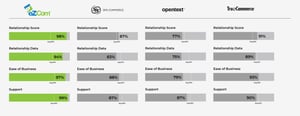Business is growing. Brand recognition is up. And drop ship orders are soaring. Great news, except that EDI and order processing seems to consume more and more time. How can a company scale, and process more EDI transactions and orders in less time? The solution: automate EDI and order processing as much as possible.
Business is growing. Brand recognition is up. And drop ship orders are soaring. Great news, except that EDI and order processing seems to consume more and more time. How can a company scale, and process more EDI transactions and orders in less time? The solution: automate EDI and order processing as much as possible.
At eZCom, we are constantly working to make our Lingo EDI software deliver an even more seamless experience for the customers who rely on it, replacing high-touch, error-prone, manual entry with automation that can be preset and defined for each trading partner.
How Automation builds better retailer and customer relationships.
- Saves valuable time for staff
- Improves the level of service provided by the supplier or brand
- Mistakes are reduced, and documents are sent to retailers in less time
- Suppliers are then considered valuable, reliable partners.
Suppliers with their own growing online presence need to ship direct-to-consumer orders as efficiently as possible. What’s more, people who make purchases from eCommerce stores have been conditioned by the likes of Amazon and Walmart.com—they expect the products at their doorstep in, at most, a few days. And they want to be able to monitor the shipping process.
While the human touch that great customer service can provide remains vital, automation means the supply chain can work at the pace that is now expected. What’s more, when you automate EDI and order processing, you free up additional time that can be used to provide the kind of person-to-person follow up that helps brands cement lasting relationships with buyers.
How Lingo Can Automate EDI and Order Processing
- Item Reference, Document Tags, and other information becomes automated
- Item Reference: delivers crucial information the trading partner may fail to provide
- Document Tags: Tags ensure that all users, warehouse staff, a 3PL provider can easily see the status of an order as it moves through the system, and the remaining steps are clear to all parties.
- Users only need to view the platform if there is an issue:
- An invalid item or number sent by a trading partner
- A document like an Invoice that needs to be adjusted
- An adjustment is needed to items in current inventory
With Lingo, the process can be fully or partially automated. The level of automation may vary since the requirements of each trading partner can be quite different. Sometimes, manual updates are necessary when shipping multiple orders to distribution centers, or when sending a bulk order. Even in those instances, however, the batch processing features in Lingo make it easy to apply these updates to multiple orders at the same time.
To automate, Lingo users need to establish the following in Trading Partner settings:
- Document Tags
- Item Matching
- Automated Tasks
In System settings, Lingo users can establish:
- Released Status
In both Trading Partner and System settings, Lingo users can establish:
- GS1 Prefix, serial numbers for document IDs/BOL, and more
- Item/Carton Maintenance
Orders that are made consistently—the same items, packed the same way each time—are ideal for maximum automation. Once the settings are established for these kinds of orders, each one can be handled automatically by the system. To make it work, Lingo users do the following in advance:
- Enter the specific items into Item Reference
- Provide the required information for each item
- Provide Pack Information
- Establish carton dimensions (weight, volume)—since this is a consistent order, these don’t change each time
Document Flow
Remember that different trading partners will have EDI and order processing requirements that are specific to their process and supply chain needs. While many documents are used universally, they are not always used by all trading partners. The following automated presets can be established for each trading partner, based on the information carried by the Document Tag that is automatically applied once matched in Item Reference:
- Purchase Order Acknowledgment. Can be automatically created and sent.
- Shipment. Packing and creation of parcels can be automated. GS1-128 labels, shipping labels, and packing slips can be automatically generated and emailed.
- Send Shipment. Ship according to the schedule established in Trading Partner settings—no need to adjust or input for every order. This is especially valuable for trading partners who rely on a Just-in-Time process.
- Invoice. Create and send automatically, based on the schedule established in Trading Partner settings.
- Factor Invoice. Can be created automatically when the Invoice is sent.
- Inventory Reporting/Feed. Lingo will automatically send it based on retailer requirements established in Trading Partner settings.
- Catalog. Create and send automatically according to the schedule established in Trading Partner Settings.
- Email notifications. Can be preset so users automatically receive alerts when documents are transmitted or an issue emerges—the item is not in Item Reference, the price is incorrect, the identifiers don’t match. In Settings, users can also establish which staff member is alerted for each issue.
More automation equals less time spent on EDI and order processing.
With automation and the right full-service provider, companies gain more time to pursue new opportunities and establish better relationships with their retail trading partners and customers. Our Lingo software transforms EDI and order processing from a necessary, time-consuming requirement into a genuine competitive advantage.






